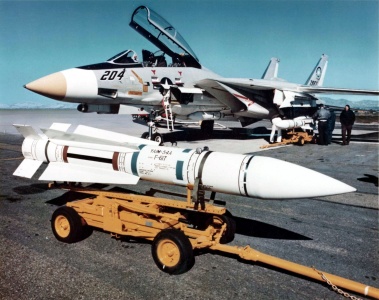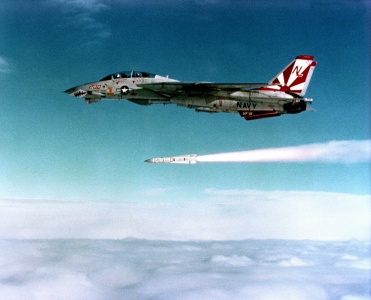AIM-54A Phoenix
Contents
Description
The AIM-54A Phoenix is an American active radar homing missile. It was introduced in Update "Danger Zone". The AIM-54A Phoenix is the first active-radar homing missile to be introduced in War Thunder.
Vehicles equipped with this weapon
General info
| Missile characteristics | |
|---|---|
| Mass | 447 kg |
| Guidance | ARH+IOG+DL |
| Signal | CW |
| Lock range | 16 km |
| Launch range | 150 km |
| Maximum speed | 4.3 M |
| Maximum overload | 16 G |
| Missile guidance time | 100 secs |
| Explosive mass | 60.54 kg TNTeq |
Effective damage
The AIM-54 is equipped with a 60 kg TNT warhead, capably of destroying targets with wide proximity fuze.
Comparison with analogues
Compared to the 2nd longest range missile in the game, AIM-7F Sparrow, the Phoenix has much longer range, but sacrifices manoeuvrability heavily.
Usage in battles
While taking more than 2 of these missiles isn't recommended in regular RB maps, an F-14 pilot can climb to about 5000 meters after take off and launch at any target it sees, preferably high altitude targets. Backing up to their team right after. In EC maps, this missile can be launched in groups to different targets at very long ranges by F-14 pilots.
Pros and cons
Pros:
- Has an active radar homing (ARH) seeker, which gives it fire-and-forget capability
- Can reach ranges that no other weapon system in the game can reach, if high enough in altitude can hit targets beyond 50 km
- Extremely fast at high altitudes after some acceleration
- Can be launched in TWS, which gives target no radar lock notification until the missile goes pitbull
- Has decently wide proximity radius which the missile can explode
Cons:
- Can only pull 16Gs, anybody paying attention can easily dodge by changing directions
- Only usable in long ranges, won't even track in close ranges
- Extremely heavy, it takes a lot of time to reach the speeds that its effective at
- May lose track right after the launch if TWS lock is lost
History
Development of an American long-range air-to-air missile trace back to the 1958, when Hughes was awarded a contract by the United States Air Force for the GAR-9 missile (designated in 1962 as the "AIM-47"), which was to have a range of 160 kilometers (100 miles) and a 45 kg (100 lb) warhead. Due to the long-distance required, the missile was given an active radar seeker in order to attack their target. The US Navy, seeking a fleet-defense weapon since the late 1950s, took interest in the GAR-9 design as a potential candidate and contracted Hughes in 1962 to develop a new long-range air-to-air missile for their fleet interceptor, designated "AAM-N-11" and would be later designated in June 1963 as the AIM-54A Phoenix.[1]
Compared to the preceding AIM-47, Hughes' AIM-54 featured an AN/DSQ-26 semi-active radar homing seeker for cruising while receiving updates on target position. The missile switches over to active radar homing for the terminal attack around 18 km from the interception point. The AIM-54 featured a Rocketdyne Mk47 or Aerojet Mk60 rocket motor that helped propelled the missile more than Mach 4. The missile maintain the range specification of 160 km and was to be able to attack both aircraft and cruise missiles. The warhead is a 60 kg (132 lb) MK 82 blast-fragmentation warhead that was trigger by a fuse system consisting of radar proximity, IR proximity, and an impact fuse.[2]
Flight tests of the prototype (XAIM-54A) started in 1965, with the first interception tests taking place on 08 September 1966 at the Navy Pacific Missile Range, fired from a Douglas A-3A Skywarrior.[3] The aircraft platform for the AIM-54 Phoenix was originally the F-111B, an aircraft intended to have commonality with the US Air Force's F-111 Aardvark, but this was cancelled in 1968. The US Navy set to work building a new fleet-defense fighter to their specifications on 03 February 1969, which produced the F-14A Tomcat, which was to carry six AIM-54 missiles linked with its AN/AWG-9 radar, allowing the aircraft to fire all six AIM-54 missiles simultaneously at separate targets.[1]
Hughes received a production contract for the AIM-54 missile in December 1970 as more tests with the missiles continue to show its capabilities. During November 1973, the missile passes its technical evaluation and is slated to be ready for deployment with the F-14A. The F-14A's capability with the AIM-54 was shown during an exercise on 21 November 1973, with the missile officially adopted into the US Navy service the same year and ready to be operationally deployed with the F-14A in November 1974. At the time, the missile costed $477,131 USD, which is roughly $3 million USD in 2022 adjusted for inflation.[3]
Other variants of the AIM-54A developed, primarily for training purposes, were the ATM-54A with an inert warhead for firing exercises, the CATM-54A as a non-launching missile for target acquisition practice, the DATM-54A for ground-handling training, and the AEM-54A that contained telemetry electronics for test and evaluation purposes.[2]
The AIM-54A would continue production until 18 November 1980 with a total of 2505 units as it was replaced by the improved AIM-54C Phoenix missile.[3]
The AIM-54A Phoenix would never be used in combat in F-14As piloted by American crew. Instead, most of the AIM-54A aerial victories were scored by the nation Iran, which ordered F-14s and AIM-54A Phoenix missiles in 1972 and acquired them prior to the Islamic Revolution. During the Iran-Iraq War, it is reported that the Islamic Republic of Iran Air Force (IRIAF) is credited with 62 victories with the use of AIM-54 Phoenixes.[4]
Media
- Images
See also
Links to the articles on the War Thunder Wiki that you think will be useful for the reader, for example:
- reference to the article about the variant of the weapon;
- references to approximate analogues by other nations and research trees.
External links
References
- Citations
- Bibliography
- Goebel, Greg. 2021. "[1.0] Falcon & Sidewinder." Air Vectors. Last modified July 01, 2021. Website (Archive).
- Naval Air Systems Command. 2017. "AIM-54 Phoenix Missile." United States Navy. Last modified March 10, 2017. Website (Archive).
- Parsch, Andreas. 2004. "AIM-54." Directory of U.S. Military Rockets and Missiles. Last modified October 08, 2004. Website (Archive)
- Stillion, John. 2015. Trends in Air-to-Air Combat: Implications for Future Air Superiority. Washington, DC: Center for Strategic and Budgetary Assessments.





